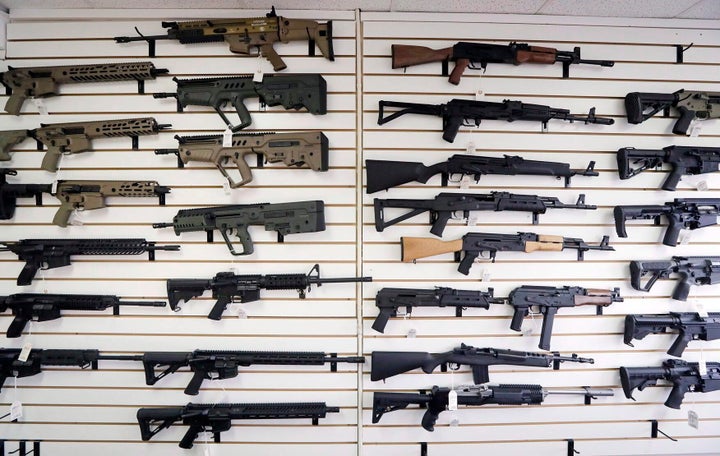On Friday, Prime Minister Justin Trudeau announced that Canada was officially banning the sale and use of “assault-style” firearms.
“These weapons were designed for one purpose and one purpose only: to kill the largest number of people in the shortest amount of time. There is no use and no place for such weapons in Canada,” Trudeau said.
“Effective immediately, it is no longer permitted to buy, sell, transport, import or use military-grade assault weapons in this country.”
The move, issued through an order-in-council by cabinet, follows the worst mass shooting in Canadian history, when a gunman murdered 22 people in Nova Scotia between April 18 and 19. It comes into effect immediately, and prohibits the use and sale of the listed firearms.

Owners will have a two-year amnesty period until April 30, 2022, to properly dispose of the affected weapons before it becomes a criminal offense to be in possession of them.
“The significant risk that these firearms pose to the public safety outweighs any justification for their continued use and availability within Canada,” the order reads.
Here’s what you need to know about the details of the ban.
What guns does this affect?
The ban affects 1,500 models and variants of “assault-style” or “military-style” weapons. The ban doesn’t immediately forbid owning any of the listed weapons and their variants, but it does forbid their use and halts the sale and trade of them as of Friday.
The phrase “assault-style” weapon is generally used to refer to a semi-automatic firearm with an ammunition magazine that is built to fire quickly in rapid succession. Magazine sizes are already restricted to a maximum of five rounds.

Public Safety Minister Bill Blair has drafted a list of the affected weapons, which is available here. Gun models including the M16, M4, AR-10 and AR-15 rifles are on the list. The AR-15 has been used in numerous mass shootings around the world in recent years, including the 2019 Christchurch mosque terrorist attack and the 2018 Marjory Stoneman Douglas High School massacre. The list also includes the Ruger Mini-14 used in the École Polytechnique massacre in 1989.
Trudeau’s government will have to amend the Firearms Act to match the ban, as it does not currently distinguish between these “military-style” weapons and other types of long guns.
When does it come into effect?
Immediately. The ban will be enacted through regulations approved by an order-in-council from cabinet — not through legislation — which means MPs from other parties will not debate and pass it.
However, the introduction of the buyback program promised by Trudeau will require legislation to be passed through the House of Commons.
What should gun owners do?
The order has a two-year amnesty period for current owners.
Justice Minister David Lametti told reporters Friday that there will be several avenues gun owners can pursue to come into compliance with the law during the two-year period, including a buyback program and grandfathering regime.
Federal officials said starting immediately, owners of the banned weapons must keep these guns safely stored until details of the buyback program and grandfathering regime are released. Owners wishing to properly dispose of their weapons can have them decommissioned by a licensed service, deliver them to a police officer, legally export them or, in the case of businesses, return them to the manufacturer. But they won’t get any monetary compensation until the buyback program is in place.
Also, if a gun owner is planning to hand their firearm over to the police, it is recommended they make arrangements ahead of time.
The government estimates that while there are 2.2. million licensed firearms carriers in Canada, the ban will affect around 90,000 currently restricted firearms and an unknown amount of unrestricted ones.
“These weapons were designed for one purpose and one purpose only: to kill the largest number of people in the shortest amount of time. There is no use and no place for such weapons in Canada.”
- Prime Minister Justin Trdueau
According to the order, Canadians using the affected firearms for sport shooting will no longer be allowed to, effective immediately. Those who use them for sustenance hunting or under constitutional Aboriginal rights will be permitted to continue to do so until the end of the two-year grace period on April 30, 2022.
According to the order, at the end of the two-year amnesty period, anyone found to be in possession of one of the listed firearms could be subject to criminal prosecution for unlawful possession.
How did we get here?
Strengthening gun control was a campaign promise of Trudeau’s Liberals during last year’s federal election. After the Nova Scotia shooting, Trudeau doubled down on that pledge.
Some guns have legitimate uses, including recreational shooting and hunting, the prime minister said, “but you don’t need an AR-15 to bring down a deer.”
The order explicitly references mass shootings in Nova Scotia, Toronto, Quebec City and Montreal as the motivation behind its creation.
The RCMP told reporters on Tuesday that the Nova Scotia gunman had been armed with two semi-automatic rifles and several semi-automatic pistols, and that one of the guns could be described as a “military-style assault rifle.”
However, the new ban likely would not have impacted his ability to obtain the guns, as RCMP say the shooter obtained them illegally.
In a statement Friday, Conservative Leader Andrew Scheer accused Trudeau of using the shooting to push forward his political agenda.
“Trudeau is using the current pandemic and the horrific attack in Nova Scotia to push his ideological agenda and make major firearms policy changes,” Scheer said. “That is wrong. The majority of gun crimes are committed with illegally obtained firearms. Nothing he announced addresses this.”
Also on HuffPost: